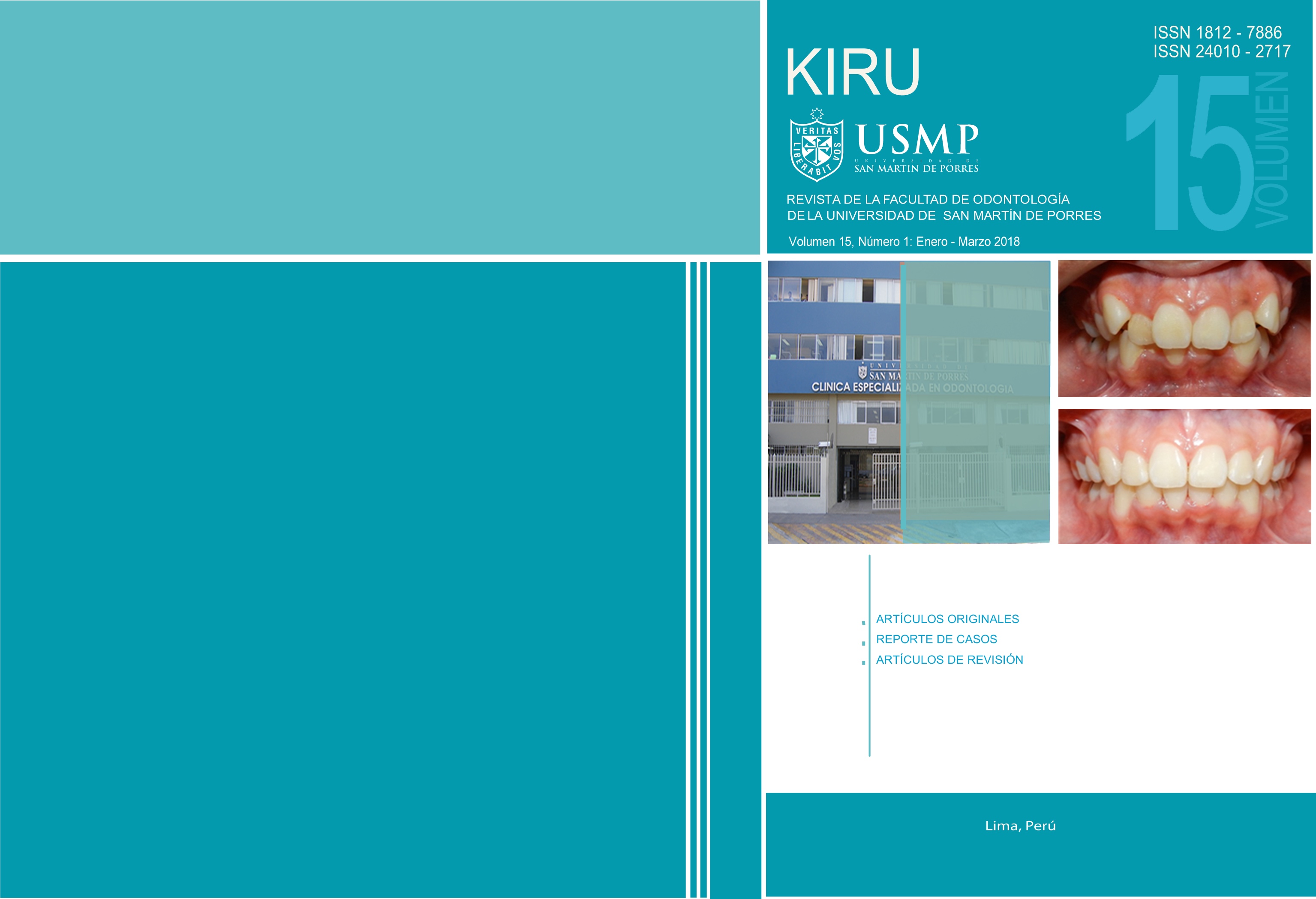Antimicrobial effect of aqueous extracts from the peel, pulp and grape seed (vitis vinifera) on Streptococcus mutans, in vitro study
Keywords:
Phenolic compounds, Grape Seed Extract, Streptococcus mutans, VitisAbstract
Objective: To determine the antibacterial activity of aqueous grape extracts (Vitis vinifera) obtained from the skin, seed and pulp, on Streptococcus mutans (ATCC 35668, Ecuador), using 0.12% chlorhexidine as a positive control and distilled water as a negative control. Materials and methods: Aqueous extracts were obtained from the pulp, seeds and grape skin of the northern region of Ecuador, at a concentration of 40, 70 and 100%, which were impregnated 20 ml each in paper filter discs. and placed in Petri dishes with strains of Streptococcus mutans inoculated on blood agar, disks impregnated in 0.12% chlorhexidine and distilled water were used as control; the antimicrobial activity was evaluated considering the inhibition zones obtained at 24 and 48 hours of incubation. Results: The evaluation times 24 and 48 were different (p = 0.00) showing a greater inhibitory effect at 48 hours, where the 100% grape seed extract presented antimicrobial activity similar to 0.12% chlorhexidine, and the 70% concentration of the same extract reduced inhibition. However, peel and pulp extracts in their different concentration did not present halos of inhibition against Streptococcus mutans. Conclusions: The aqueous extract of 100% grape seeds showed antimicrobial activity similar to 0.12% chlorhexidine against Streptococcus mutans.
Downloads
References
Paneque T, Castillo H, Piquera Y, Infante M, Ramírez M. Relación entre factores de riesgos y caries dental. MULTIMED Granma. 2018 Jul; 19(4).
Graciano M, Correa YA, Martínez CM. Streptococcus mutans y caries dental en América Latina. Revisión sistemática de la literatura. Rev Nac Odontol. 2012 Jan; 8(14):32-45.
Aurea S, Soro A. Solving the etiology of dental caries. Curr Trends Microbiol. 2015 Feb; 23(2): 76-82.
Dilip G, Sham SB, Beena A. Comparative evaluation of the antimicrobial efficacy of Aloe vera tooth gel and two popular commercial toothpastes: an in vitro study, Gen Dent. 2009; 57(3):238-241.
Ojeda JC, Oviedo GE, Salas LA. Streptococcus mutans and dental caries. CES Odontol. 2013 Jun; 26(1): 44-56.
Rivadeneira D, Álvarez P. Aceite esencial de A Schinus molle L. (Molle) como potencial antimirobiano sobre Streptococcus mutans. Estudio in vitro. Kiru. 2015; 12(2):8-14.
Rojas R, Bustamante B, Bauer J, Albán J, Lock O. Antimicrobial activity of selected Peruvian medicinal plants. J Intercult Ethnopharmacol.2003 Oct; 88(2-3):199- 204.
Krzyściak W, Jurczak A, Kościelniak D. The virulence of Streptococcus mutans and the ability to form biofilms. Clin Microbiol Infect. 2014 April; 33(4):499-515.
Pooja D, Pandurang A, Kaushik B, Dasharath O. Phenolic compounds, antioxidant activity and insulinotropic effect of extracts prepared from grape (Vitis vinifera L) byproducts. J Food Sci Technol. 2015 Jan; 52(1):181–190.
Lars M, Jennifer A, Jan M, Nicolai K. Production of plant- derived polyphenols in microorganisms: current state and perspectives. Appl Microbiol Biotechnol. 2018 Feb; 102(4):1575–1585.
Daglia M. Polyphenols as antimicrobial agents. Curr Opin Biotecchnol. 2012 Apr; 23(2):174-181.
Jiménez M, Sammán N. Caracterización química y cuantificación de fructooligosacáridos, compuestos fenólicos y actividad antirradical de tubérculos y raíces andinos cultivados en el noroeste de Argentina. ALAN. 2014; 64(2):131-135.
Vasco C, Ruales J, Kamal A. Total phenolic compounds and antioxidant capacities of major fruits from Ecuador. Food Chem. 2008 Apri; 111(4):816-823.
Serra M. Política antimicrobiana. Necesidad imperiosa ante la creciente resistencia microbiana actual. Rev haban cienc méd. 2017 Jul;16 (4):564-578.
Massón M, Armas A. Comparación de la efectividad antibacteriana de la stevia rebaudiana sobre streptococcus mutans y streptococcus sanguinis. KIRU. 2016;13(2):127-132.
Delgado AJ, Gamero SE, Valdés SE. In vitro estimation of the antibacterial activity and antioxidant capacity of aqueous extracts from grape-seeds (Vitis vinifera L.). Food Sci Nutr. 2011 Sep;51(18): 2481-2485.
Carbone Z, González MM, Martínez SE. La Saliva: Una Mirada Hacia El Diagnóstico. CNH RAAO. 2016; 55(2): 39- 43.
Berradre M, Vides A, Ojeda G, Soto L, Sulbarán B, Fernández V, et al. Caracterización fisicoquímica y actividad antibacteriana del aceite de semillas de uva (Vitis vinifera) variedad Malvasía. Rev. Fac. Agron. (LUZ).2016 Feb; 33(1): 619-625.
Paladino SC, Zuritz CA. Extracto de semillas de vid (Vitis vinifera L.) con actividad antioxidante: eficiencia de diferentes solventes en el proceso de extracción. Rev. FCA UNCUYO. 2011 Abril; 43(1): 187-199.
Swadas M, Dave B, Vyas SM, Shah N. Evaluation and Comparison of the Antibacterial Activity against Streptococcus mutans of Grape Seed Extract at Different Concentrations with Chlorhexidine Gluconate: An in vitro Study. IJCPD. 2016 Jul; 9(3):181-185.
Garcia SS, Blackledge MS, Michalek S, Su L, Ptacek T, Eipers P, et al. Targeting of Streptococcus mutans Biofilms by a Novel Small Molecule Prevents Dental Caries and Preserves the Oral Microbiome. Adv Dent Res. 2017 Mar; 96(7):807-814.
Galarza C, Armas A, Núñez MA. Myrtus communis como alternativa natural sobre cepas de microorganismos bucales: streptococcus mutans y streptococcus sanguis. Kiru. 2016;13(1):45-50.
Downloads
Published
Issue
Section
License
- Los autores/as conservarán sus derechos de autor y garantizarán a la revista el derecho de primera publicación de su obra, el cuál estará simultáneamente sujeto a la Licencia de reconocimiento de Creative Commons que permite a terceros compartir la obra siempre que se indique su autor y su primera publicación esta revista.
- Los autores/as podrán adoptar otros acuerdos de licencia no exclusiva de distribución de la versión de la obra publicada (p. ej.: depositarla en un archivo telemático institucional o publicarla en un volumen monográfico) siempre que se indique la publicación inicial en esta revista.
- Se permite y recomienda a los autores/as difundir su obra a través de Internet (p. ej.: en archivos telemáticos institucionales o en su página web) posterior al proceso de aprobación del manuscrito, lo cual puede producir intercambios interesantes y aumentar las citas de la obra publicada.







